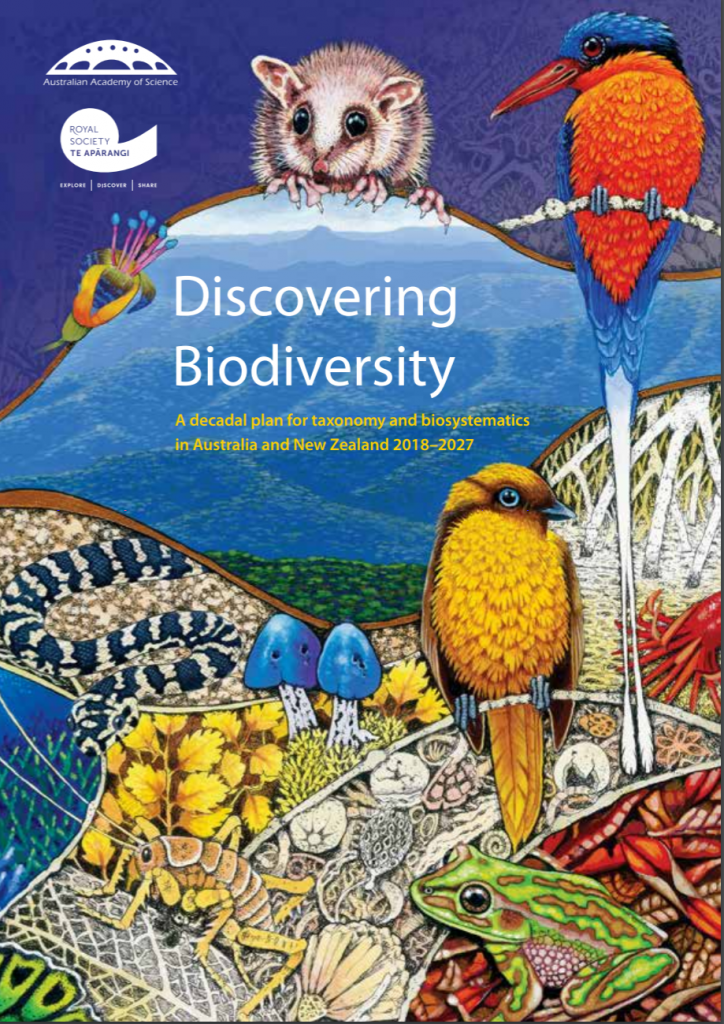
Discovering Biodiversity: A decadal plan for taxonomy and biosystematics in Australia and New Zealand 2018–2027
I recently attended an online forum presenting the outcomes of a major review of Australia’s taxonomic resources, as part of Taxonomy Australia’s Decadal Plan. Their mission is to:
discover and document all remaining Australian species of plants, animals, fungi and other organisms … in a generation.
The Decadal Plan for Taxonomy and Biosystematics in Australia and New Zealand (2018–2027) recommended 22 strategic actions grouped under six key initiatives. Together, these provide a vision for the future that would see a substantial acceleration in the discovery and documentation of the Australasia’s biodiversity.
Taxonomy Australia is developing more detailed implementation plans for each of these strategic actions, in consultation with the taxonomy and biosystematics sector and with key stakeholders, of which this forum was a part.
The video introduction runs you through the the scope and intent of the national workshop, and these wrap-up videos outline the results of the ten ambitious roundtable discussion groups.
In the first stage of synthesis from these roundtables deliberations a list of action items was distilled:
- build a collaboration space that combines an expertise directory (online register of taxonomists), a portal for shared field work, and a clearing-house mechanism to connect citizen scientists and scientists for taxonomic projects and a coordinated recognition system for citizen science contributions to taxonomy,
- streamline the permitting process in every state to reduce the burden on collectors applying for permits,
- start writing shorter, faster morphological descriptions,
- agree on a controlled name-space for informal species (Operational Taxonomic Units),
- create a new specialised journal for rapid taxonomic description and publication,
- reach community consensus on how to integrate molecular and morphological data, especially when they conflict,
- measure the economic value of our collections (independently from their replacement cost),
- design collections now for years 5, 10 and 25 years of our mission, and
- start including funding for collections activities in grant applications.
These actions are promising and we commend the efforts of Taxonomy Australia. Taxonomy, the science of naming and classifying, is a global practice; species are not confined by regional boundaries and so taxonomists work to describe new species in their family of expertise, wherever they are found. Therefore, coordination at a national level to discern and describe new taxa benefits all the component states.
Much of this nationally-coordinated taxonomic effort will streamline the work of Western Australia’s recently announced Biodiversity Information Office (BIO) not least because, in such a biodiverse State, there remain so many species yet to be discovered, described, and their conservation status assessed.
The primary aim of the BIO is “to enhance the timeliness and efficiency of environmental assessment processes and approvals” and has come about through concerted efforts by the Western Australian Biodiversity Science Institute (WABSI). Gaia Resources has been involved in the development of the BIO concept – Piers and the team have led the development of the technical plan alongside WABSI.
WABSI also led the establishment of the Index of Biodiversity Surveys for Assessments (IBSA), launched in May 2018, in conjunction with the Department of Water and Environmental Regulation, as a publicly accessible repository that captures and consolidates data from more than 500 biodiversity surveys each year. Again, Gaia Resources has been involved – our work on streamlining the lodgement of assessments within the Environmental Impact Assessment project has also been launched.
And in late 2019, the Prime Minister announced progress towards a nationally consistent digital environmental assessment and approvals regime, in partnership with Western Australia. You can read more on this in the Digitally Transforming Environmental Assessment report.
Through the development of these projects, as well as shared data repositories and the establishment of the WA’s ‘Environment Online’ digital portal, the State is rapidly developing a comprehensive framework for biodiversity assessment. Taxon names, to return to the start, are the fundamental key to integrating, maintaining and reliably using these amassed datasets. In fact, they drive the whole ‘data ecosystem’.
If you’d like to discuss any of the topics covered in this post, please drop me a line at alex.chapman@archive.gaiaresources.com.au, or connect with us on Twitter, LinkedIn or Facebook.
Alex


Comments are closed.